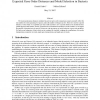RECOMB
2010
Springer
14 years 1 months ago
2010
Springer
In comparative genomics, various combinatorial models can be used to specify gene clusters — groups of genes that are co-located in a set of genomes. Several approaches have been...
SAC
2002
ACM
14 years 2 months ago
2002
ACM
Two independent sets of recent observations on newly sequenced microbial genomes pertain to the prevalence of short inversion as a gene order rearrangement process and to the lack...
NAR
2006
14 years 3 months ago
2006
The Yeast Gene Order Browser (YGOB) is an online tool designed to facilitate the comparative genomic visualization and appraisal of synteny within and between the genomes of seven...
DAM
2008
14 years 3 months ago
2008
In comparative genomics, one wishes to deduce the evolutionary distance between dierent species by studying their genomes. Using gene order information, we seek the number of time...
BMCBI
2007
14 years 3 months ago
2007
Background: Homology is a key concept in both evolutionary biology and genomics. Detection of homology is crucial in fields like the functional annotation of protein sequences and...
ALMOB
2008
14 years 3 months ago
2008
Background: Identification of homologous regions or conserved syntenies across genomes is one crucial step in comparative genomics. This task is usually performed by genome alignm...
CSB
2003
IEEE
14 years 8 months ago
2003
IEEE
As gene order evolves through a variety of chromosomal rearrangements, conserved segments provide important insight into evolutionary relationships and functional roles of genes. ...
GCB
2007
Springer
14 years 9 months ago
2007
Springer
The most parsimonous distances calculated in pairwise gene order comparisons cannot accurately reflect the true number of events separating two species, unless the number of chan...
RECOMB
2002
Springer
15 years 3 months ago
2002
Springer
Comparing chromosomal gene order in two or more related species is an important approach to studying the forces that guide genome organization and evolution. Linked clusters of si...




